I know it seems such an awful cliché but it’s hard not to conjure up images of Count Dracula when you hear the name Transylvania. This was one of my fascinations with the central region in Romania, not that I’m obsessed with vampires – I’ve never (voluntarily) seen an episode of ‘Twilight’ – but there is something curious about the tale of Vlad the Impaler and the historical events which inspired the famous novel by Bram Stoker.
When you see Bran Castle, you can imagine the degree of dread for those who had to enter under less than inviting circumstances. Its original function was as a fort and strategic defence point looking out over the Bran gorge, one of the major trade routes into Transylvania, so it makes sense that it looks foreboding.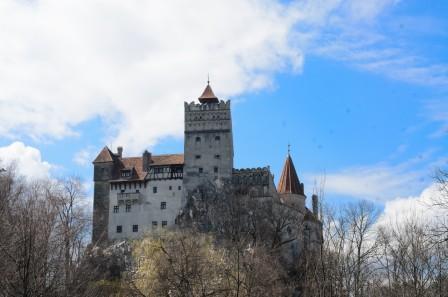
Inside however is a lot more hospitable than you might think given its slightly sinister exterior.  It was a lot smaller in size than I expected, with low ceilings, but it also has an intriguing layout with lots of passageways and turns and twists, so you feel constantly unsure of which level you’re on and where you’ll come out.
It was a lot smaller in size than I expected, with low ceilings, but it also has an intriguing layout with lots of passageways and turns and twists, so you feel constantly unsure of which level you’re on and where you’ll come out.
The castle later served as a royal residence, but is still rather modest in furnishings. There are some spectacular examples of wooden carved furniture and a hard to miss bear rug.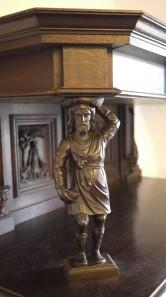
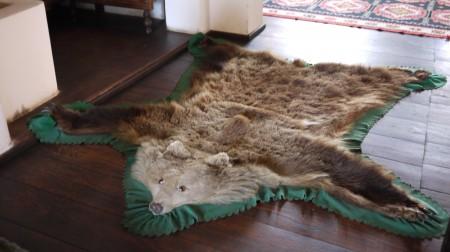
The other main interest I had in Transylvania was the beautiful countryside, and those of its residents which most would associate more with North America than Eastern Europe, namely the Brown Bear.
After our tour of the castle we were met by the ‘Transylvanian Wolf’ a guide who has closely researched bears, wolves and lynxes in the area. A short drive from Bran, through some of the scenic Romanian countryside and we arrived at the edge of a forest near the Carpathian Mountains. The fields at the base of the hills are used for grazing by local shepherds. As we approached the start of our trek we saw five or six sheep dogs at the outskirts of a flock of sheep, some dozing, others barking when they saw us. 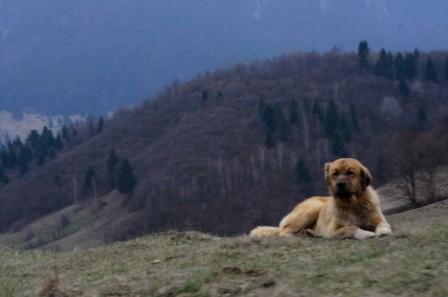 These we discovered were canine bodyguards which would protect the sheep against bears or wolves coming down from the woods in search of food. They had spiked collars to prevent predators biting the dogs’ necks. We soon realised how necessary it was to protect the flock. A shepherd earns about 200 Euros a month, but to lose one cow for example, would mean a loss of around 400 Euros, which the shepherd would have to compensate the owner for. Undoubtedly a hit to a shepherd’s pocket and a shepherd’s reputation.
These we discovered were canine bodyguards which would protect the sheep against bears or wolves coming down from the woods in search of food. They had spiked collars to prevent predators biting the dogs’ necks. We soon realised how necessary it was to protect the flock. A shepherd earns about 200 Euros a month, but to lose one cow for example, would mean a loss of around 400 Euros, which the shepherd would have to compensate the owner for. Undoubtedly a hit to a shepherd’s pocket and a shepherd’s reputation.
The forest we trekked through consisted mostly of spruce and beech trees. 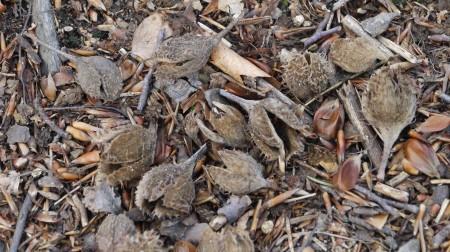 The beech trees we were told are an important source of food for the bears, as the beech nuts allow the brown bears to put on 100 kgs of fat for them to live off during the winter period.
The beech trees we were told are an important source of food for the bears, as the beech nuts allow the brown bears to put on 100 kgs of fat for them to live off during the winter period.
Only a short time into our trek and there were already signs of bears and other wildlife. A tree stump that had its innards exposed was from a bear shredding away the bark in search of grubs.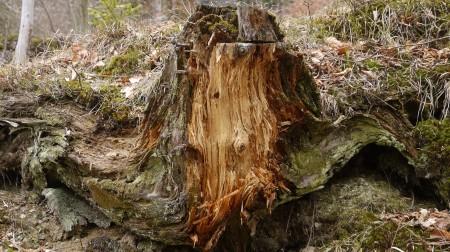 Further on our guide pointed out a tree with dried sap which had coarse brown hairs stuck to it – a sign that it had been a bear’s scratching post. The excitement levels were building, and then the guide found a paw print belonging to a cub.
Further on our guide pointed out a tree with dried sap which had coarse brown hairs stuck to it – a sign that it had been a bear’s scratching post. The excitement levels were building, and then the guide found a paw print belonging to a cub. All this tracing of DNA evidence was feeling a bit like a crime scene investigation, and we were convinced at any minute we would come face to face with a bear.
All this tracing of DNA evidence was feeling a bit like a crime scene investigation, and we were convinced at any minute we would come face to face with a bear.
At this stage the pressing question had to be asked. “What should we do if we see a bear?” I asked. The guide then went on to explain that bears are actually rather shy creatures and would most probably amble off, and are only likely to become aggressive if they are guarding ‘a kill’ or had cubs nearby.
Given a bear’s timid tendencies, when we came to a clearing, where bears had been previously spotted, we had to sit very quietly for about half an hour and watch the nearby grass area and the hills in the distance. After no sightings, we kept walking, becoming excited at the discovery of more tracks – this time it looked like a mother bear and cub. The track went hot and cold so we settled in another clearing which gave us stunning views of the valley beyond and the striking Carpathian Mountains.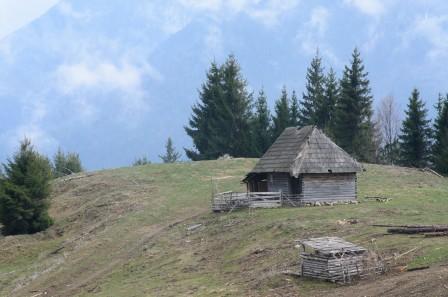
There was a lot more quiet waiting, searching the trees and hills using binoculars and a lot of speculating about where our illusive furry friends could be. After a bit more walking the disappointing reality dawned upon us that we would probably not be seeing bears today. Even if we hadn’t seen bears, perhaps they’d seen us. Afterall, it was only recently that these Romanian bears would have woken from their ‘deep sleep’, which generally starts in December and lasts through to late March.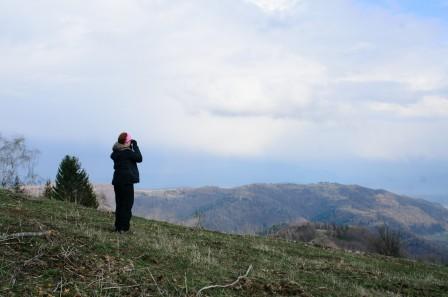
We would have loved to have seen bears and with around 6,000 of them, I thought the odds were good. But it was still fascinating to learn so much about the brown bears of Romania and their environs, and knowing we’d come so close. The walk alone was stunning, as we passed over green hills, and paths lined with wild spring flowers.
The forest is also home to many different species of birds, including the woodpecker, whose handy work we encountered – perfectly circular holes drilled into trees, so that pine cones can be inserted to enable easy pecking of their seeds.
So our quest for bears had been unsuccessful, but we weren’t too disheartened, as we knew we’d had the privilege of strolling through their home. We decided that next time, we would go a little later in the year, perhaps when the summer berries would be too hard to resist and would draw the bears out into the open for us to admire…….from a safe distance of course.
Tips for visiting Bran Castle
From Brasov, catch the bus to Bran, which is 7 Lei per person, one way. It only takes about 30 minutes and leaves Brasov on the hour, every hour, and sometimes at half past the hour.
At only 25 Lei per person (approximately £5), Bran Castle is reasonably priced, and a visit will only take about 30 minutes to an hour.
For the best angle of the Castle, take photos on the opposite side from the main entrance.
Bear conservation
Despite no actual sightings, we learned a lot about the Romanian brown bears, who are the same species as those in North America. Our guide/tracker, the ‘Transylvanian Wolf’ was keen to share his extensive knowledge and explained how bears are often ‘misunderstood’ and in this area they live relatively ‘harmoniously’ with the neighbouring villages (particularly when you compare the low incident rate with other parts of the world). The main threats seemed to be against the bears who had developed a taste (and smell) for rubbish, some of whom had fallen foul of plastic packaging.
Others had suffered at the hands of poachers, and although only a small number, park rangers are apparently quite vigilant. It appears as though the Romanian government has for some time recognised bears as an important resource for the area, along with the forests, which are regularly ‘audited’ looking at the composition of the forest and how it needs to be managed to support its special ecosystem. Part of this management has been to allow, where bear numbers are sustained or have increased, a small number of bears to be hunted, which brings significant revenue to support the preservation of the forest and the bear population, as well as supporting the local economy.
Many staunch anti-hunting types would strongly disagree with this approach and I tend to agree. Ultimately those able to afford the 7,000 Euros for the bear hunting permit are interested in the thrill of the hunt and/or the head and fur as the prize, which must only encourage the perception of these creatures as trophies. However, you do have to acknowledge that bear numbers in Romania are steady and much more healthy than the small numbers in France, although as I understand it, the threat there has been largely from farmers concerned for their livestock.
Bear sighting options
If you don’t want to risk disappointment of not seeing bears, you could opt for viewing them at one of the bear hides organised by the Romanian Forestry Ministry, where bears are lured to the sight by the planting of food. This does raise the question of how ‘natural’ this is and how good it is for the bears if they start to rely on this as a food source.
There is also a bear sanctuary in Zarnesti, which we read good reviews about, but didn’t have time to visit.
As with many travel activities, it’s a balance of time, cost and sometimes a test of what you think it means to be ‘a responsible tourist’.
by Kelly Ley-Dahm

